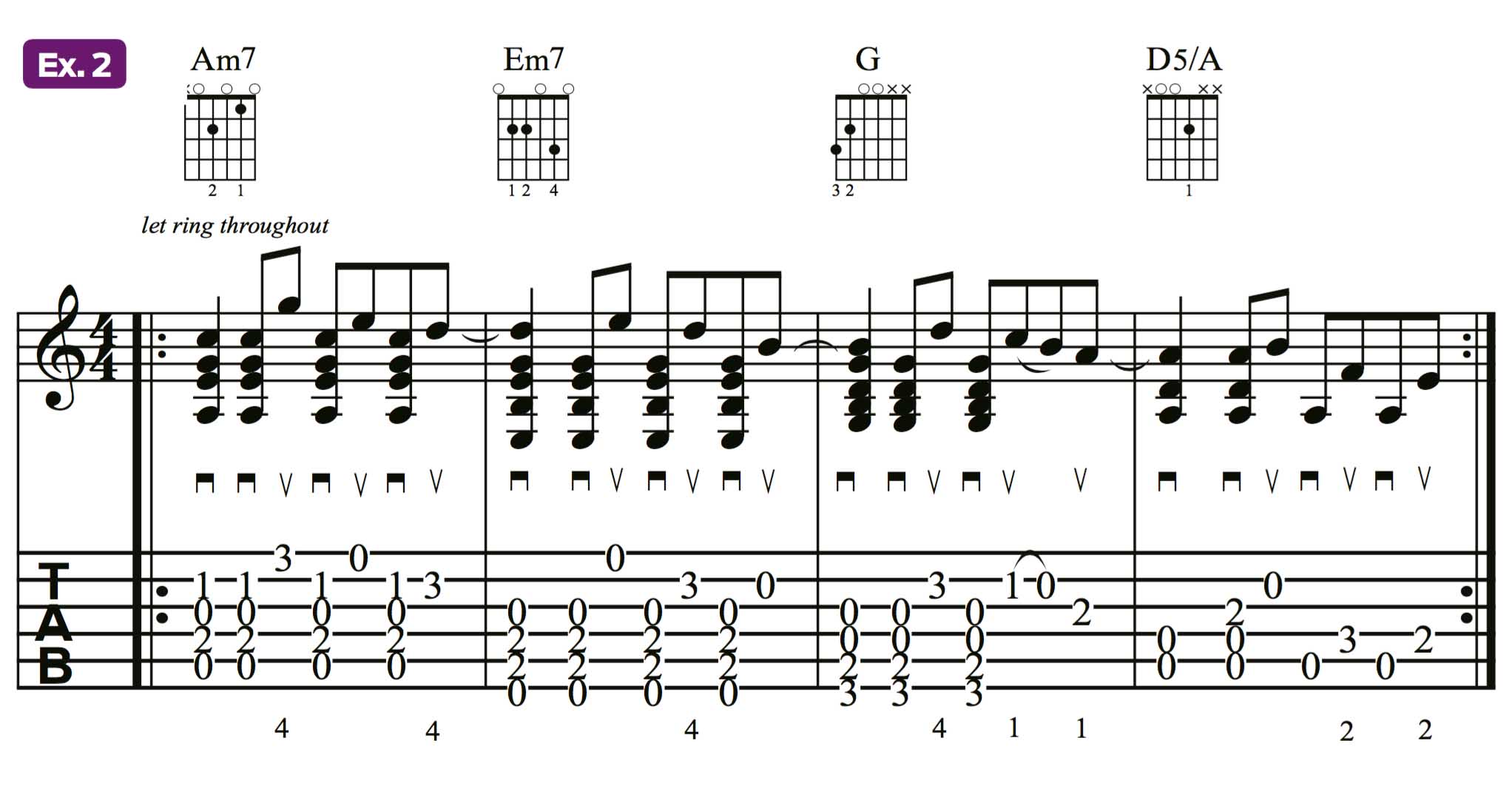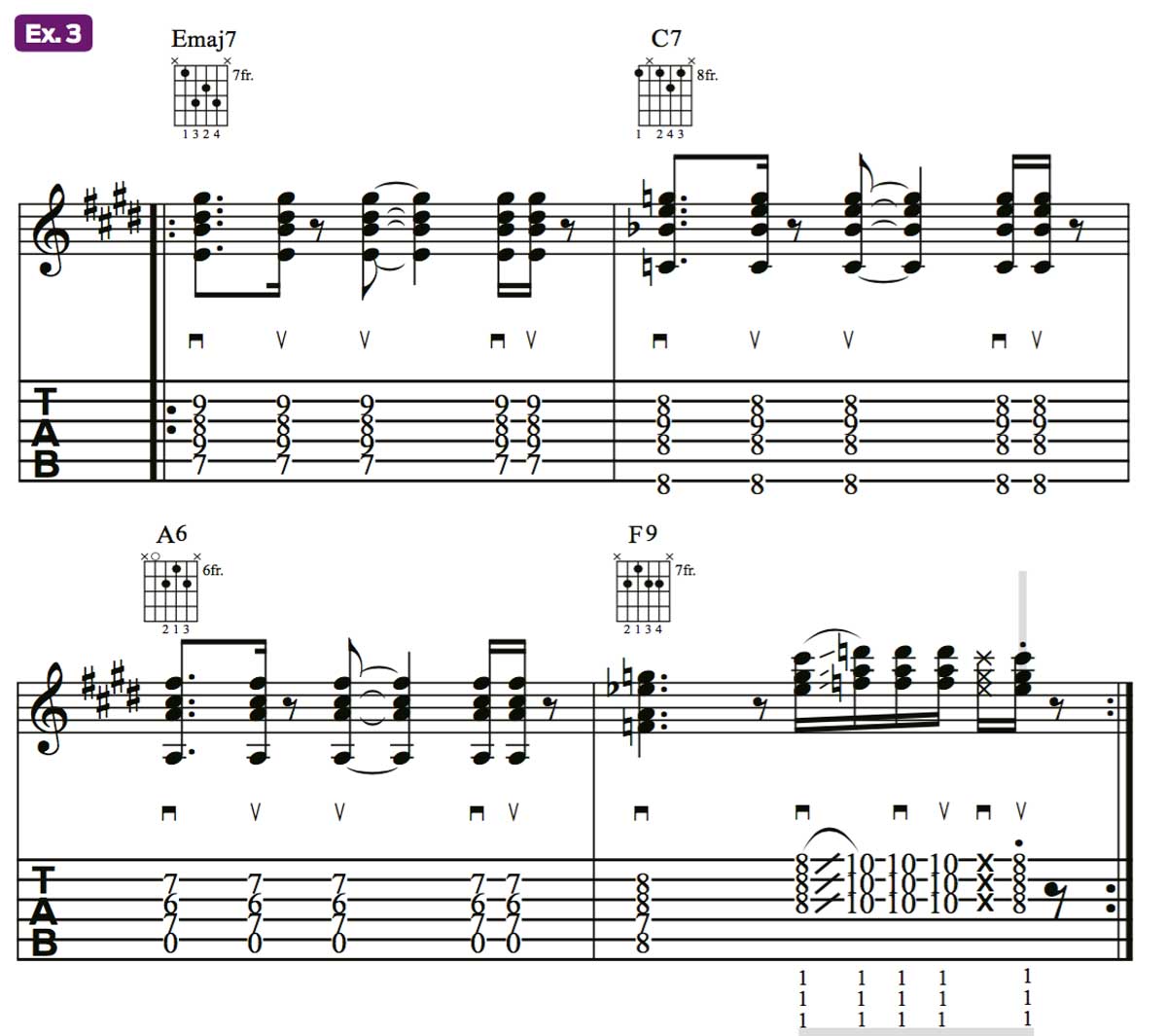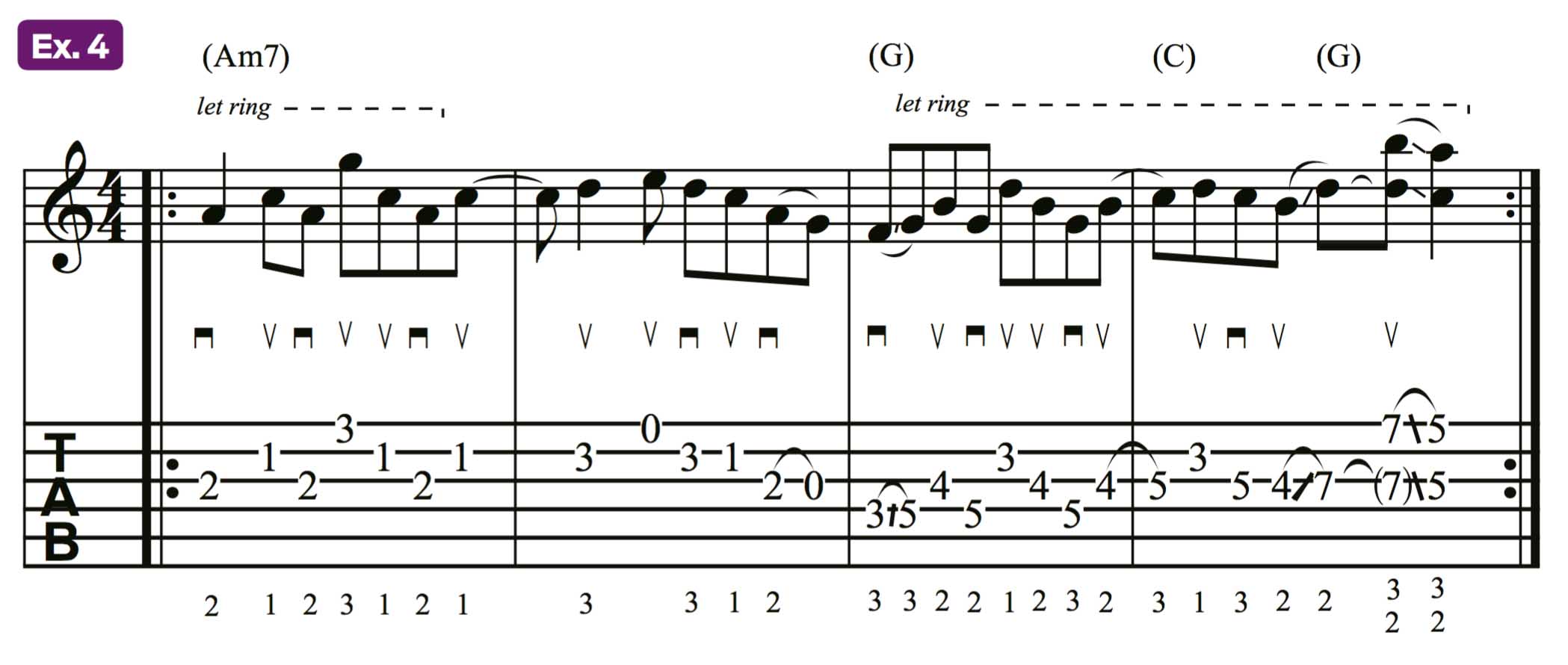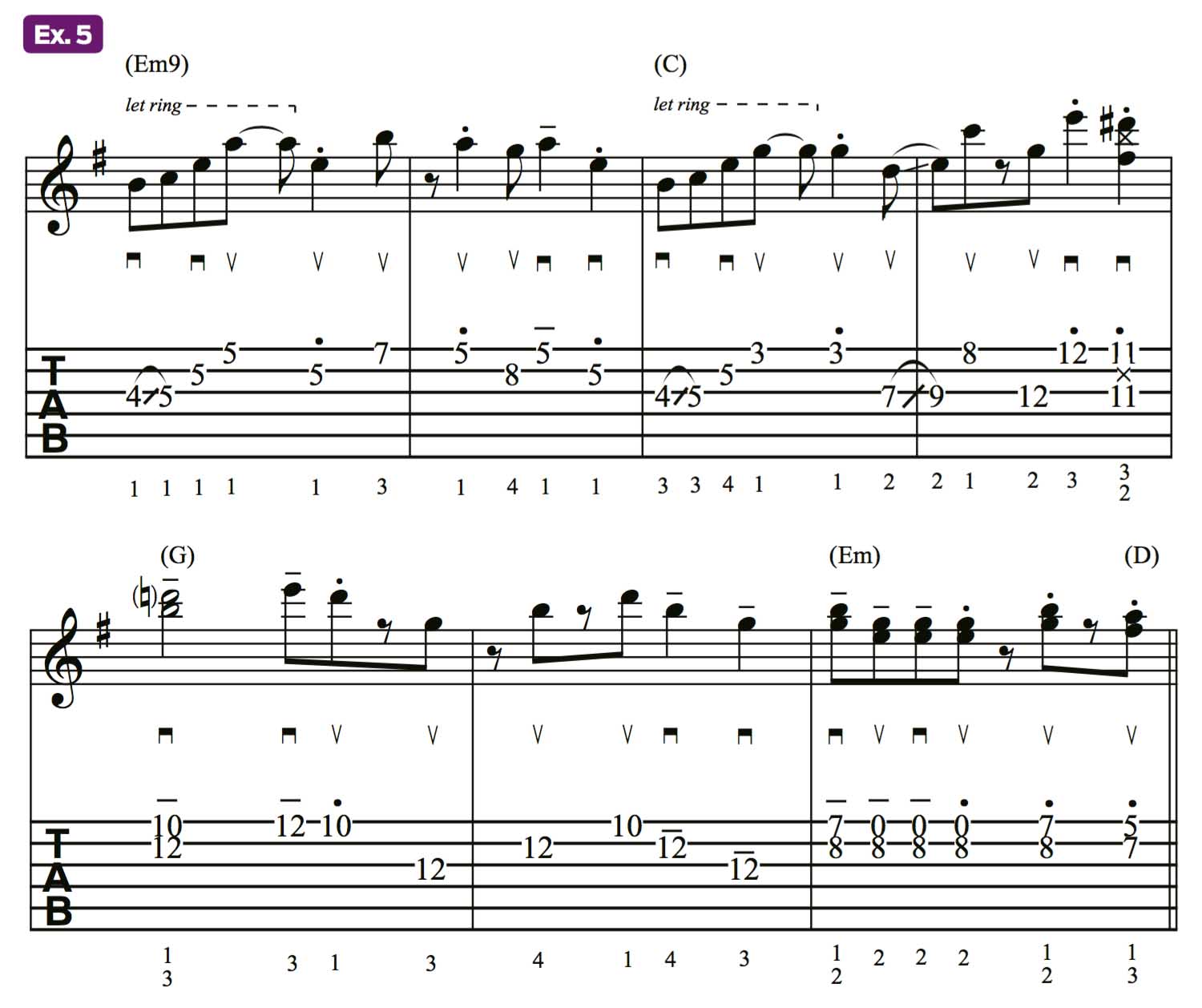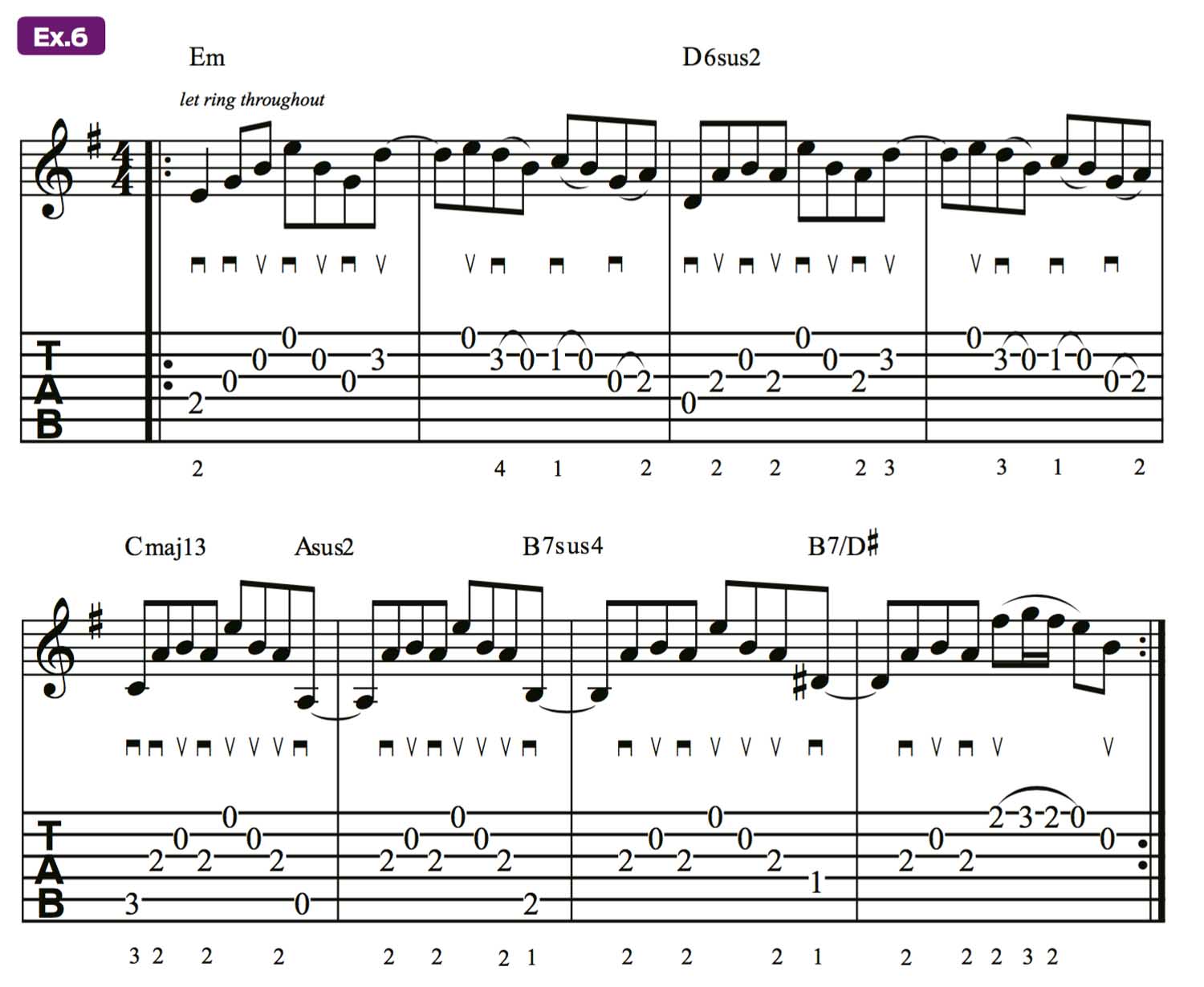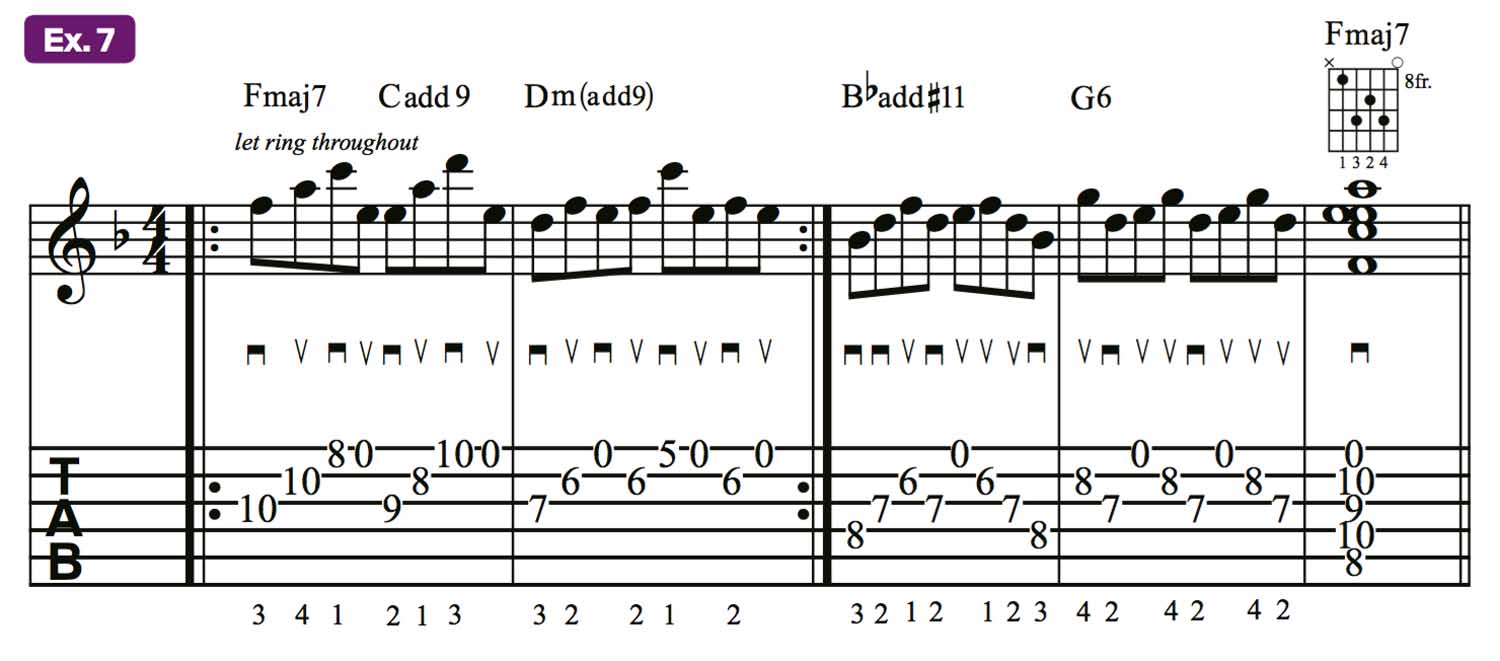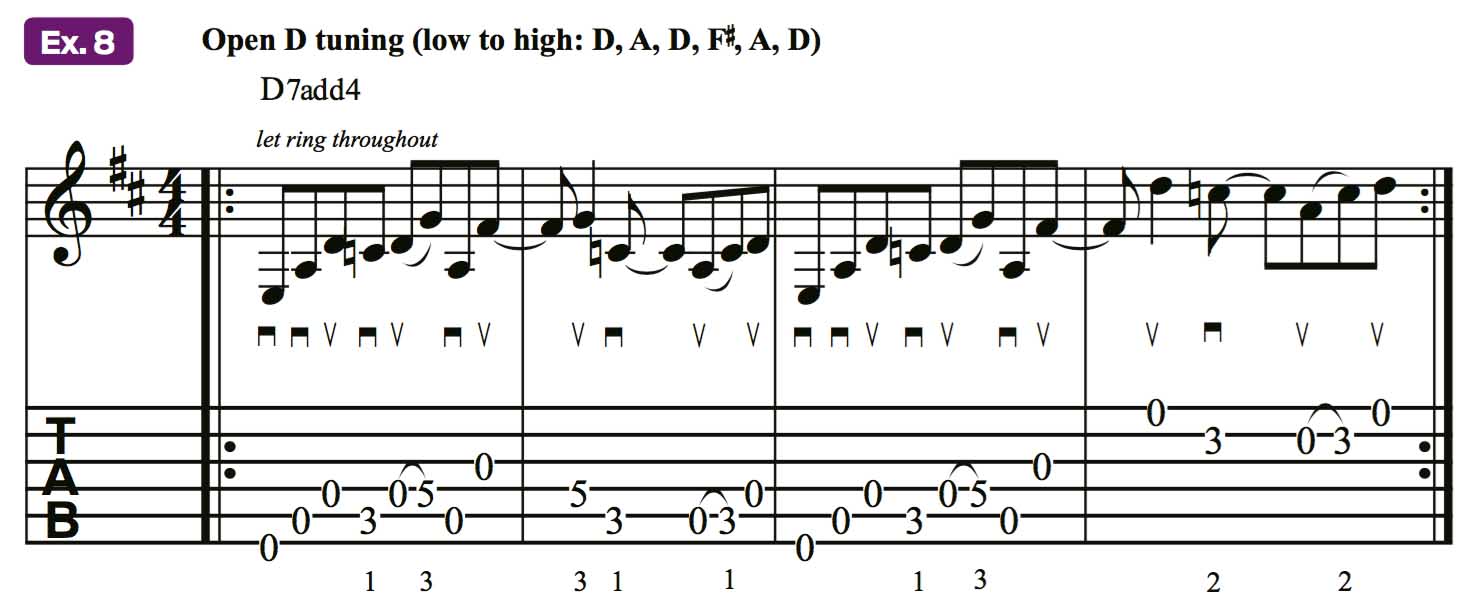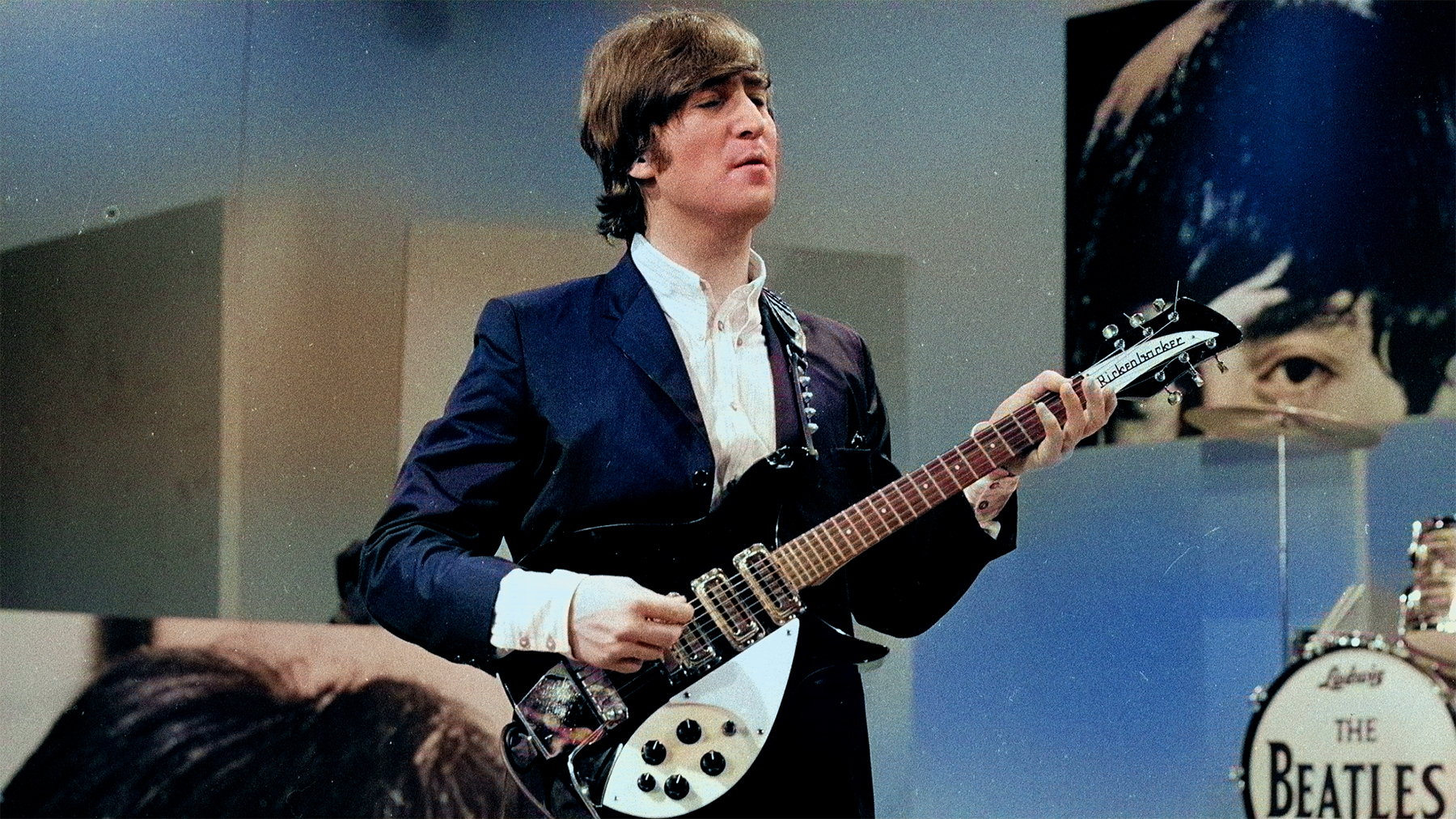The Ultimate Johnny Marr Guitar Lesson
Capture Johnny Marr's signature lead-rhythm style by learning arpeggiated chords, open-string licks and unusual progressions in the style of the former Smiths guitarist

Though the Smiths lasted a mere five years, from 1982 to ’87, they may be one of the most influential rock acts of their time. Much of this acclaim stems from the indelible fretwork of guitarist Johnny Marr.
Influenced by everything and everyone from Motown to Jimi Hendrix to African highlife music, Marr’s playing shifted the focus from the massive blues-based riffs of ’70s rock guitar to a more nuanced approach that combined the chime of ’60s jangle-pop bands with the pared-down musicality of players like Nile Rodgers and Keith Richards.
After the Smiths’ breakup, Marr went on to play with Talking Heads, Billy Bragg and Pet Shop Boys, among others, and launched a successful solo career, influencing guitarists like Jonny Greenwood and Noel Gallagher.
In this lesson, we’ll break down the elements essential to Marr’s eclectic approach, including his use of elements such as open strings, arpeggios, rhythmic syncopation and melodically layered chord progressions.
Since this lesson leans heavily on chord voicings and fretboard movement, be sure to note the picking/strumming and fret-hand fingering prompts included in each of these examples.
Marr's Rhythm Guitar
Being the Smiths’ sole guitarist, Marr had a lot of sonic ground to cover. In the studio, he could overdub multiple guitar parts to achieve the multilayered textures he wanted, but onstage, he had to combine the essence of rhythm and lead textures into his playing (although the Smiths did add a second guitarist on their final tour).
To do so, Marr would seamlessly meld both lead and rhythm guitar when he played. Part of his genius was in writing rhythm parts that incorporated functional melodies within them, and crafting leads that retained the necessary harmony that a rhythm guitar would normally provide.
All the latest guitar news, interviews, lessons, reviews, deals and more, direct to your inbox!
Example 1 demonstrates this kind of integrative approach to rhythm guitar. Inspired by the intro to the Smiths’ “Cemetry Gates” (The Queen Is Dead), the example utilizes an upbeat 16th-note rhythm guitar pattern with a simple but catchy melodic motif woven into it.
We start by playing a standard open C chord before moving into a far less standard Dadd4-9/A (voiced, low to high: A, F#, G, D, E). You make this transition by simply taking the C chord shape and moving it up a whole step (two frets) on the neck while removing your 3rd finger from the A string, leaving it open, along with the G and high E strings. You then head into bar 2 playing an open Gmaj7 chord (voiced G, D, G, B, F#).
As you strum this chord, alternate the high F# note, played at the 2nd fret on the high E string, with the open E note, momentarily transforming the chord to G6 (voiced G, D, G, B, E). Adding this simple but effective melodic motif on top of the chord progression gives an otherwise okay-sounding rhythm part an additional layer of interest.
Informed by one of Marr’s finest solo tunes, “New Town Velocity” (The Messenger), Example 2 delves deeper into this concept. Throughout the figure, you alternate between strumming open chords on the beats and picking out single notes on the eighth-note upbeats, forming a descending melody on top of the chords, all in 1st position.
These single notes are played above each chord while you hold the lower chord tones.
We begin by strumming Am7 (voiced A, E, G, C) on beat 1, then add the single notes G (high E string, 3rd fret), open high E and D (B string, 3rd fret) on the upbeats – or “and” counts – of beats 2, 3 and 4. From there we switch to an open Em7 chord (voiced E, B, E, G, D) and continue adding high melody notes in a similar fashion.
In bar 3, we shift the melodic pattern slightly: Over an open G chord, fretted with the 2nd and 3rd fingers on the bottom two strings, we proceed to “walk down” the B string starting from D at the 3rd fret to C at the 1st fret, which we then pull off to the open B note, followed by A on the 2nd fret of the G string.
In the final bar, we strum the power chord D5/A (voiced A, D, A) for the first two beats, with only the open A note taking the place of the strummed chord on beats 3 and 4, as the melody descends and crosses over to the D string with the notes F and E at the 3rd and 2nd frets.
Two additional hallmarks of Marr’s approach to rhythm guitar are his use of 7th chords and 16th-note syncopations, both of which helped produce the kind of unique, almost jazzy sounds that set the Smiths apart from their rock contemporaries.
Inspired by the band’s masterpiece “Heaven Knows I’m Miserable Now” (Hatful of Hollow), Example 3 starts with an Emaj7 chord (voiced E, B, D#, G#) strummed in a funky, staccato fashion that evokes the rhythm playing style of one of Marr’s biggest influences, legendary funk and disco pioneer Nile Rodgers.
When strumming, keep your pick hand moving back and forth across the strings in a flowing, unbroken, down-up-down-up motion, even during the rests. (This highly useful technique is called 16th-note pendulum strumming, and it’s the key to making riffs like this groove and feel “in the pocket.”)
Strum this rhythm through the next two bars as you shift to C7 (voiced C, Bb, E, G), and A6 (voiced A, A, C#, F#). As you enter bar 4, hold on the chord F9 (voiced F, A, Eb, G), then play a funky, sliding triple-stop lick through beats 3 and 4. Barre your 1st finger across the top three strings at the 8th fret, then slide up a whole step to the 10th fret and continue strumming in 16th notes.
On beat 4, mute the strings by releasing your fret-hand grip on them, letting the index finger gently sit on the strings to keep them from ringing out as you shift back down to the 8th fret on the second 16th note of the final beat.
Once you have these techniques down, it’s time to move on and tackle Marr’s lead sound.
Marr's Arpeggios
Like the Pretenders’ James Honeyman-Scott and Siouxsie and the Banshees’ John McGeoch, Marr rejected the notion that guitar leads needed to be showy and bombastic to be impressive and impactful.
He played lines as catchy as any of Morrissey’s swooning vocal melodies while providing the harmonic support a rhythm guitarist would normally supply.
Marr often did this by building his single-note parts around arpeggios – chords broken up into single notes – and using scale tones to melodically stitch everything together.
Taking cues from the Smiths’ classic, “Still Ill” (The Smiths), Example 4 begins with an arpeggiated open Am7 chord shape, with each chord tone ringing out until you hit the C note on the “and” of beat 4 in bar 1.
From there you play an ascending and descending melodic line based on the A minor pentatonic scale (A, C, D, E, G). In bar 3, slide from F on the D string’s 3rd fret up two frets, to G, which becomes the root of an arpeggiated G major chord (G, B, D), played in eighth notes that ring together and fill out the rest of the bar.
At the end of bar 4, a couple of legato finger slides are used in conjunction with sliding 6th intervals to create a sweet, slippery-sounding ending to the phrase. The use of triads and dyads in this example is demonstrative of Marr’s melodic approach to chord movement.
Instead of simply strumming chords, he’ll break them up into single notes and connect them together via melodic phrasing.
Next we will look at the influence of African highlife music on Marr’s playing. Highlife is driven by one or more guitarists playing parts based on syncopated arpeggios and dyads (two-note chords), typically using diatonic 3rds or 6ths.
Considered by many to be one of the guitarist’s greatest musical achievements with the Smiths, the single “This Charming Man” is the song most heavily influenced by highlife guitar work in his catalog, and features some of Marr’s most technically challenging playing.
Example 5 uses a similarly fashioned highlife-style syncopated uptempo eighth-note feel and arpeggiated approach.
Note the use of legato finger slides in bars 1, 3 and 4, which lend expressiveness to the figure. When playing this example, also notice the varying articulations and durations indicated for certain notes.
Some are to be held as long as possible, or played tenuto, as indicated by a horizontal dash over the note, while others are played short, or staccato, indicated by a dot. The push and pull of these two contrasting articulations is the key to achieving the intended feel and phrasing of the example.
Opening Up
Another device Marr loves to utilize is the use of open strings. Example 6 is a flowing eighth-note riff inspired by his playing in “Hand in Glove” (The Smiths), and driven by open-chord arpeggios with shared common tones (tones that are shared between neighboring chords) that ring throughout.
Again, notice how foundational open-chord shapes are held and allowed to ring while being embellished with both open and fretted notes on the higher strings.
The combination hammer-on and double pull-off in the final bar can be a bit tricky to perform smoothly and cleanly, so practice it slowly at first, using the prescribed fret-hand fingerings and striving to make these slurred notes project loudly and clearly.
Example 7 is inspired by one of the Smiths’ poppiest singles, “Ask.” While this track is notable for featuring a massive number of separate guitar parts intertwining to create an almost orchestral sound, we’ll be focusing on one technique Marr employed to great effect in this song: the open-string pedal point.
A pedal point is a single note that’s either sustained or rearticulated with a series of chords, arpeggios or melody notes. In this derivative example, you’ll see the open high E string used as the pedal point throughout.
Notice how two- and three-note fretted chord and/or arpeggio shapes are pitted against the open E note, which enriches both the harmonic color and texture of the line, especially with the Bbadd#11 and G6 arpeggios in bars 3 and 4.
Also, note the use of economy picking in these bars, which helps make all the string crosses sound and feel smoother than they would if you attempted to use strict alternate picking here.
Finally, let’s take this open-string idea to its logical conclusion. Example 8 is performed in open D tuning (low to high: D, A, D, F#, A, D) and is a reworking of one of Marr’s greatest musical moments, the main riff from the Smiths’ “The Headmaster Ritual” (Meat Is Murder).
Here, we’re playing mostly on the bottom three strings and adding color tones at the 3rd and 5th frets to the foundational open D5 chord (voiced D, A, D), with the C note on the 5th string’s 3rd fret providing the minor, or “flatted,” 7th (b7), and the hammered-on G note at the 5th fret on the 4th string supplying the “add4,” which lends an exotic flavor to the part.
As with some of the previous examples, notice again the sprightly picking pattern and frequent string crosses, which lend rhythmic flair and energy to the figure. Be sure to try playing any of these examples with a capo, placed at various frets, to transpose everything up to a higher and brighter-sounding key, as Marr himself is often inclined to do.
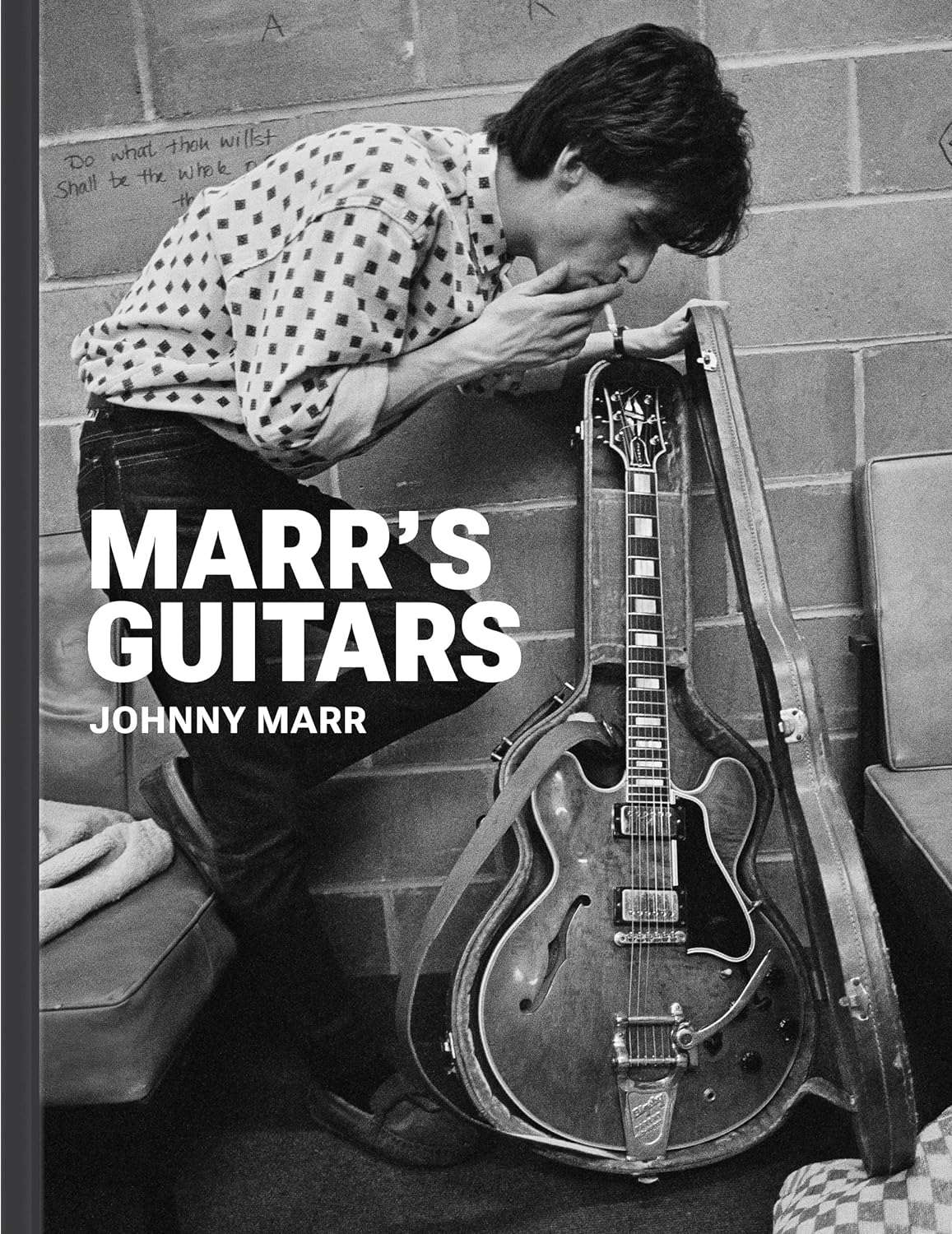
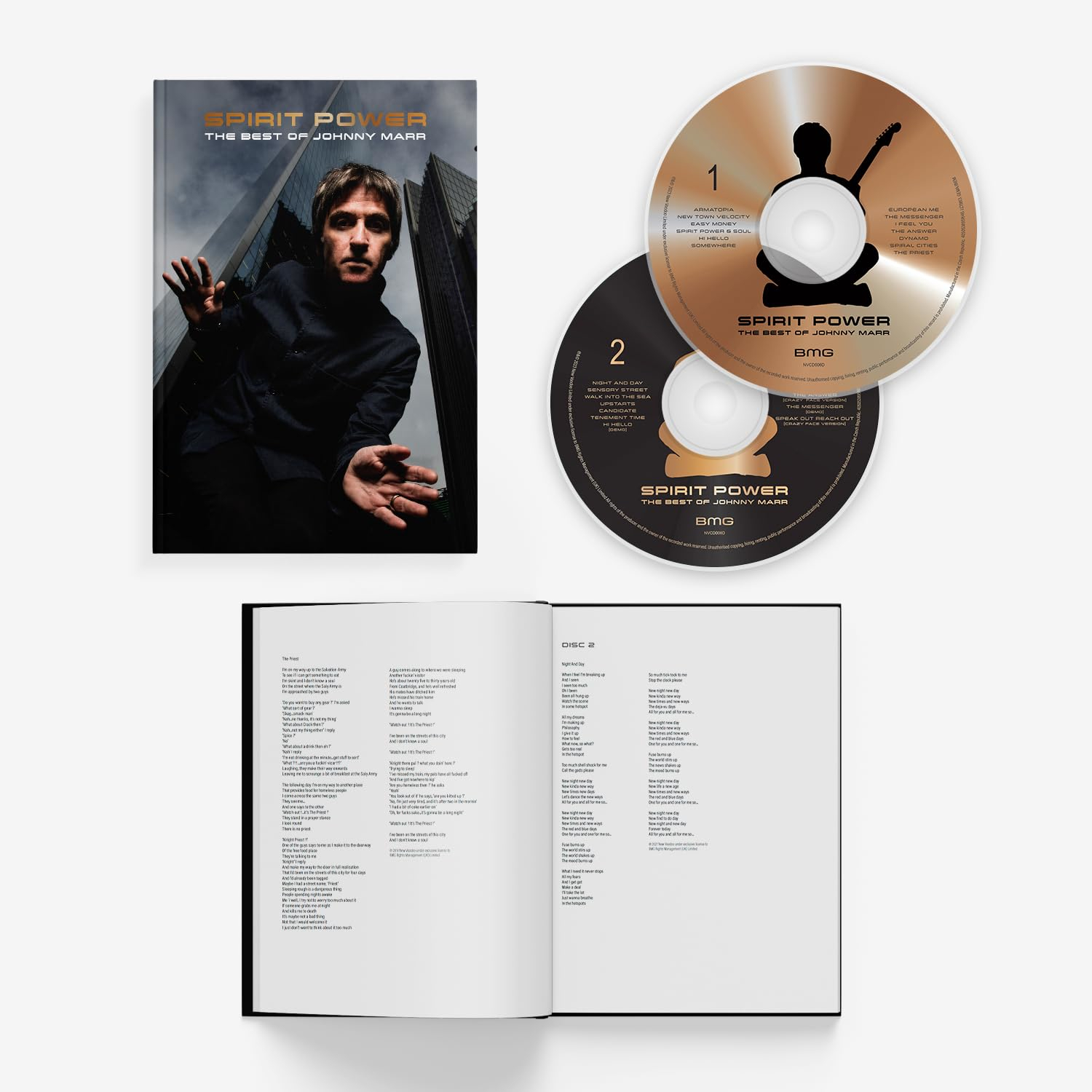
Visit the Johnny Marr website for tour info, music, merch and more.

